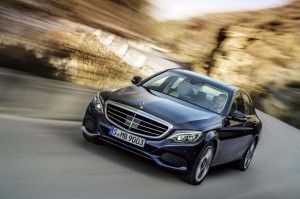Even as two key U.S. rivals reported weak earnings for the first quarter, Daimler AG delivered an unexpectedly strong performance, its net profit nearly doubling as luxury buyers raced to showrooms to snap up some of its newest Mercedes-Benz models.
The Mercedes brand has been rolling out new products at an unprecedented rate, planning, on average, about one every quarter, something that Max Warburton, an auto analyst with Sanford C. Bernstein dubbed a “powerful product cycle.”
Virtually every number showed improvement during the quarter. Net earnings rose to 2.050 billion Euros, of $2.232 billion, from 1.09 billion Euros a year ago. Revenue, meanwhile, surged 16% for the quarter, to 34.2 billion Euros.
Daimler’s profit margin, meanwhile, jumped from 7% during the first quarter of 2014 to 9.4%.
(Ford falls short for Q1. Click Herefor the full story.)
In turn, the report sent shares of the Stuttgart-based Daimler surging nearly 3% in European morning trading.
“As a result of our substantial investment, we are profiting from a strong product portfolio,” proclaimed Bodo Uebber, the financial chief on the Daimler AG supervisory board. “In combination with the systematic continuation of our efficiency measures, we will continue our profitable growth,” he forecast.
The weaker Euro helped the German maker boost its earnings. That was on top of strong pricing in the key U.S. and Chinese markets, it noted. But the ongoing product roll-out was the critical factor for the first quarter, when sales of Mercedes vehicles jumped 18%, to 459,700 vehicles, worldwide.
(Mercedes greenlight’s GLC Coupe concept. Click Here to check it out.)
Among the strongest of the new offerings was the Mercedes-Benz C-Class which recently went through a complete redesign. But the luxury brand’s line-up has been refreshed top to bottom, with new high-performance AMG models as well as additional entry-lux offerings such as the small GLA crossover introduced last autumn.
(GM Q1 earnings miss the mark. For more, Click Here.)
Daimler, nonetheless, faces a number of challenges. That includes an overall slowdown of the Chinese automotive market where Mercedes products had just begun to regain momentum after several slow years. And the high-line marque isn’t the only one rapidly expanding its line-up. Key German rivals BMW and Audi are taking a similar approach. The latter, a subsidiary of Volkswagen AG, plans to expand its current product count by 50%, to 60 different models before the end of the decade.
In the critical U.S. market, where Mercedes and BMW have largely dominated over the past half-decade, Japanese rival Lexus has been building its own momentum. And the two domestic luxury brands, General Motors’ Cadillac, and Ford’s Lincoln, have launched their own comeback strategies backed by waves of new product.
The challenge for all the luxury brands is the high up-front cost of adding new models. That’s all the more costly due to the demand for new high-tech safety, comfort and convenience features. Daimler has laid out a strategy of becoming one of the leaders in the emerging field of autonomous vehicle technology.


Interesting: M-B sales surging on ACCESSIBLE C-Class cars, as well as higher-end models. Make that well-made, attractive, safe, electronically advanced, pleasantly performing ACCESSIBLE C-Class cars. Send a copy of this story to Cadillac’s Johan DeNysschen.
I personally have found the C class to be a disappointment compared to other M-B models. They had to cut costs to make the C class “accessible” to everyone under the Sun… and it shows IME.